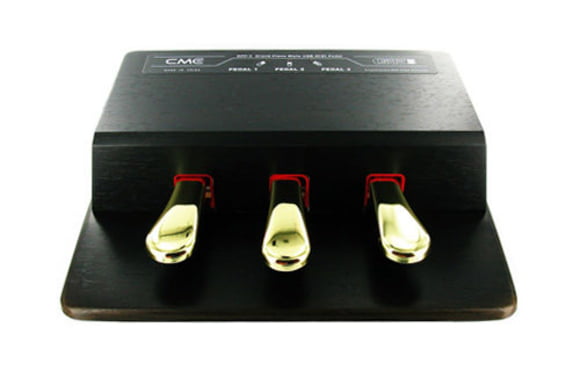6. Controls
The most obvious controls for any piano are the pedals. Which must, as mentioned above, be purchased separately for some stage pianos. Pay attention to the stability and the construction when purchasing because in the course of their life the pedals will be stepped on an innumerable amount. Additionally they can’t constantly slide around on smooth surfaces, achieved either through weight, rubber contacts, or both for some models. Light pedals made of plastic only won’t work well on stage.
Many keyboardists get by with just one sustain pedal but if you want to connect more you'll need to make sure that your stage piano has enough inputs. In the case that you prefer the classic two pedal set up: There are models with two pedals in one housing which minimizes the clutter at your feet. Not all pedals are built the same though. There are models which operate simply as switches (sustain on/off) as well as expression pedals which are similar to a wah-pedal used by guitarists. If you’re unsure which to get our expert or sales departments would be happy to help!

If you’re looking for an instrument that offers real time control of the sound parameters then you should look for one with freely assignable knobs and switches through MIDI commands. Alternatively there are separate controller boxes available for purchase. The pitch and modulation wheels are both common and indispensable controls on most stage pianos, allowing you to control pitch and vibrato or if assignable, many others parameters. For playing purely piano music these wheels, also sometimes replaced with a joystick on and X and Y axis, aren’t necessary. But as soon as you start using or synthesizing other sounds these controls become essential for reproducing them authentically.
Many keyboardists adore the classic sound of an old Hammond organ which, for many reasons, is replaced with a digital version on stage. For those who want to play organ music on their stage piano and can’t live without sound control through a drawbar there are two options:
1. Purchase an external MIDI controller which provides the appropriate sliders. This assumes however that the instrument's tone generator has a "drawbar mode".
2. Purchase a stage piano which already has a drawbar function built in. Some very popular instruments in this category are the Nord Stage or Nord Electro from Clavia.

- What is meant by polyphony or polyphonics?
- What is MIDI?
- What should I look for in the controls?
- What is arranger?
The term polyphony refers to how many tones can be heard simultaneously. The technical capabilities of an electronic instrument is, as with a computer, limited by the capacity of its built in chip(s). The more tones an instrument should control, the more data the processor needs to be able to…well…process.
If you check the technical specifications of a digital piano you will see polyphonic specifications of 32, 64, 128 or even 258 notes. Your first reaction may be to think that you would never play more than 10 or so notes at once (unless you’re Jerry Lewis who also played with his feet). But you need to be conscious of the fact that you’re in the digital world now and that every note received, from a pedal for example, must be counted in terms of the polyphony. For digital pianos with stereo samples you’ll need to pay attention to the fact that the polyphonic value given is halved, as there are two ‘’voices’’ for each sound or sample. The higher the polyphonic value, the more closely the sound will resemble a real piano because multiple resonations and overtones can be played concurrently.
MIDI (Musical Instrument Digital Interface) is a data transfer protocol that allows digital information about pitch, tone length, and sound type to be communicated, recorded, or played back between individual instruments or between instruments and computers. More information about this subject can be found in our online guide for keyboards.
Many digital pianos have a MIDI-interface, generally an input and output, designated as MIDI-IN and MIDI-OUT. This allows you to access another keyboard or connect to a computer with a sequencing program. Notation programs also usually support MIDI protocols. Another option is to download songs with MIDI ports, especially onto devices which don’t have an USB port.
When selecting a digital piano you should make sure that the knobs, sliders, panels and other controls are easy to reach while playing. Is it, for example, possible to switch easily between sound settings? Is it possible to select built-in effects and other functions with the press of a single button? Is there a touchscreen? Or are all parameters only selectable through a tiny LCD screen with cumbersome controls? An e-piano is essentially a computer developed by hardware and software specialists, and sometimes they just forget that a musician isn’t interested in reprogramming the entire system. So make sure the instrument will do what you want it to, and that you can ask it to do that on the fly!
Arranger is a function which allows the player to be accompanied by (play along with) different styles from several instruments. This function can be found on most keyboards as well as digital pianos. At the push of a button an entire band or orchestra can be imitated according to the rhythms and styles of the player. For example, the player can make a cymbal rhythm in C major with an orchestra sound.
Your Contacts
Product Highlights
-
Stage Pianos






